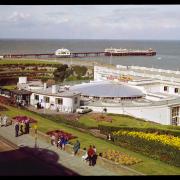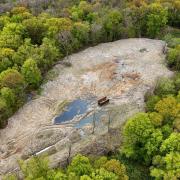The Kent village of Knowlton is home not only to a remarkable World War I memorial but to a remarkable sparing of lives, as Stephen Roberts discovers in an exploration of Kent’s only Thankful Village, where no villager was killed in battle
Armistice Day and Remembrance Sunday are important dates on the calendar in my household. My late father-in-law fought throughout WW2, seeing action at Tobruk and 2nd El Alamein, so remembering has an added poignancy. Going back further, virtually every community in the UK suffered losses in the Great War of 1914-18, so their war memorials naturally become the focus of remembrance every November. What of the small number of villages lacking a memorial, though?
The term ‘Thankful Village’ dates back to the 1930s, when it was coined by journalist, editor and writer, Arthur Mee (1875-1943), to describe a village that lost no men in the Great War. Of around 16,000 villages in England Mee positively identified 24 that could be termed ‘Thankful’, while conjecturing that there could be as many as 32, a figure now adjusted up to 57. There are no Thankful (or Blessed) villages in either Scotland or Northern Ireland, while it is thought France’s only example is Thierville in Normandy. There is only one such village in Kent; Knowlton, ten miles north of Dover and a part of Goodnestone civil parish. There are only 14 villages in England and Wales that are ‘Doubly Thankful’, having had all their members of the armed services also survive World War II. Knowlton is not among these.

The statistics are staggering and bring home the scale of loss from both wars, but especially from WW1. When we journey through these beautiful islands, virtually every community we find has a war memorial, but what of the Thankful Villages? What, for example, should we make of Knowlton? It may not have lost any service personnel during WW1 but it nevertheless does have a memorial that proclaims: ‘This cross was erected in honour of those twelve men of Knowlton who out of a total population of thirty nine enlisted prior to March 1915 and by their patriotic action won the Weekly Dispatch Bravest Village competition’. The memorial is situated on fairly busy Sandwich Road and is not that apparent, so could easily be missed; it’s also a tad overgrown - although hopefully that will be rectified. It feels like an important part of our history.
The competition that resulted in the Knowlton memorial was organised in 1914 to find the UK’s ‘bravest village’, the criterion being the one ‘from which the largest proportion of its men volunteered to serve in the armed forces before 28th February 1915’. Nearly 400 villages participated, the prize a cross of Aberdeen granite some 17 feet high, with figures of a nurse, soldier, casualty and ‘Victory’ at the top and a roll of honour on the plinth below. The then Attorney General, Lord Birkenhead, judged the competition and decreed that Knowlton, which had narrowly pipped the Scottish village of Mannock, should get the cross. This was duly unveiled in the village in September 1919 by Lord Stanhope with all but two of the 13 Knowlton men attending. That unveiling was a huge event, making the pages of The Times a week later: ‘Bravest village memorial unveiled at Knowlton, Kent’. The piece credited the place as both a ‘beautiful village’ and ‘an old but diminutive hamlet’. There was a manor house with farm, lodge (a Lutyens build of 1912), dower house, and a couple of cottages.

That might seem like an apt juncture to wrap up the story with Knowlton delivered of its cross, but research into the village’s 13 (13 names are mentioned on the plinth, although - mysteriously - wording on the cross refers to '12 men') has raised questions about their residency when they enlisted. Major Francis Elmer Speed was Squire of Knowlton and High Sheriff of Kent and was resident at the manor house, Knowlton Court, along with his two sons, John and Douglas, and made it pretty clear he expected all male staff and labourers to sign up. The trio of Speeds were joined by Corporal Charles Baldock, a gardener and resident of Home Farmhouse, the only other one of the 13 living in the village at the time. The others appear to have been estate workers, but not Knowlton residents, living instead in the neighbouring villages of Chillenden, Rowlings and Eastry. Another key figure was Major Sydney George Hewlett Sargent, rector of Knowlton since 1904, and influential in recruiting not only in this village but in the district generally.
Knowlton is a small place mentioned in Domesday Book. Come the 1931 census the then civil parish had a population of just 18. Unsurprisingly the village church, St Clement’s, is now redundant and in the care of the Churches Conservation Trust. It’s open on a daily basis, though, so can be visited. At the time of WW1 and the bravest village competition the rector lived at Chillenden, a picturesque village about a mile west of Knowlton. The village once had a halt on the East Kent Light Railway (1916-1948), which opened a year or two after those gallant lads had joined up. Knowlton Court, with its close-on 2,000 acres of parkland, is located here, and was built by Sir Thomas Peyton in 1585, with some rebuilding two centuries later.

Knowlton can be proud of its status as a ‘Thankful Village’ for there is something about these lucky communities that sets them apart but also binds them together. Knowlton is also proud to join the citizens of this country each November to remember those who were less fortunate. For, while celebrating Knowlton’s good fortune as Kent’s sole thankful village, we must never lose sight of the bigger picture. The villagers here are only too well aware of Knowlton’s unique status within Kent and the good fortune of their forebears who marched away to fight yet returned to tell the story. In a sense it’s a village that stands apart and yet, each November, it’s very much a part of our Remembrance commemorations.
Locally the Knowlton cross is known as ‘the memorial to nobody’. I feel that some of the wording on the plinth puts it more eloquently and poignantly: ‘One crowded hour of glorious life is worth an age without a name’.
THOSE WHO SERVED
Major F.E. Speed, Royal East Kent Yeomanry
Major S.G.H. Sargent, C.F. (Chaplain to the Forces)
Captain E.J.L. Speed M.C., 2nd Life Guards
Captain D.C.L. Speed, 60th Rifles
Corporal C. Baldock, 4th Buffs
Corporal L. Martin M.M., Royal East Kent Yeomanry
Corporal C. Crocker, 2nd Life Guards
Private W.J. Brett, 6th Buffs
Private J. Lack, Royal East Kent Yeomanry
Private P. O’Brien, Royal East Kent Yeomanry
Private C. Sturdee, 4th Buffs
Private T.J. Wilkins, Royal East Kent Yeomanry
Private A. Wood, 4th Buffs



























